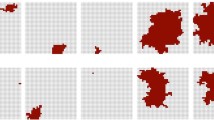Abstract
In this article we investigate a problem within Dempster–Shafer theory where 2q−1 pieces of evidence are clustered into q clusters by minimizing a metaconflict function, or equivalently, by minimizing the sum of weight of conflict over all clusters. Previously one of us developed a method based on a Hopfield and Tank model. However, for very large problems we need a method with lower computational complexity. We demonstrate that the weight of conflict of evidence can, as an approximation, be linearized and mapped to an antiferromagnetic Potts spin model. This facilitates efficient numerical solution, even for large problem sizes. Optimal or nearly optimal solutions are found for Dempster–Shafer clustering benchmark tests with a time complexity of approximately O(N 2log2 N). Furthermore, an isomorphism between the antiferromagnetic Potts spin model and a graph optimization problem is shown. The graph model has dynamic variables living on the links, which have a priori probabilities that are directly related to the pairwise conflict between pieces of evidence. Hence, the relations between three different models are shown.
Similar content being viewed by others
Author information
Authors and Affiliations
Rights and permissions
About this article
Cite this article
Bengtsson, M., Schubert, J. Dempster–Shafer clustering using Potts spin mean field theory. Soft Computing 5, 215–228 (2001). https://doi.org/10.1007/s005000100084
Issue Date:
DOI: https://doi.org/10.1007/s005000100084




